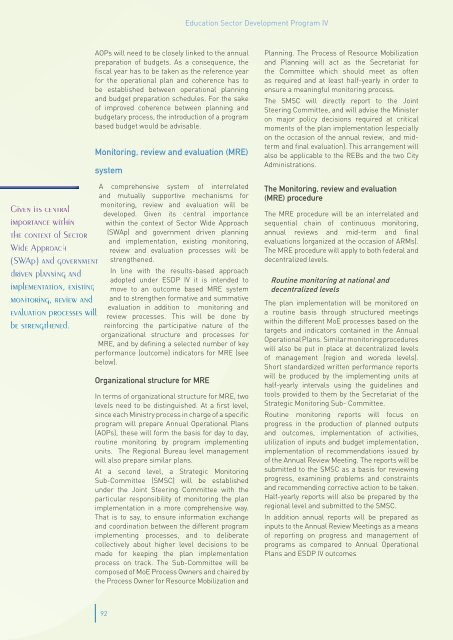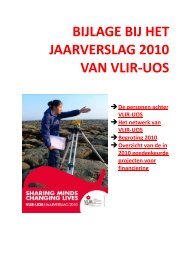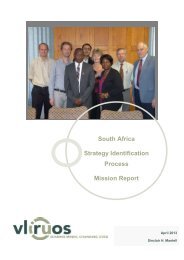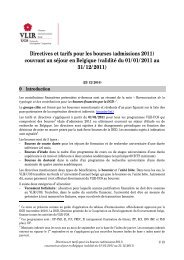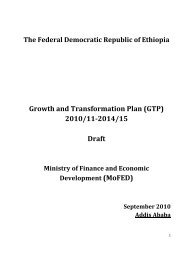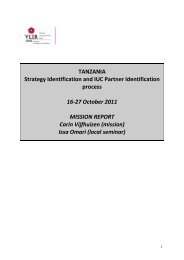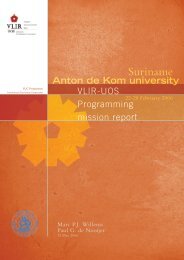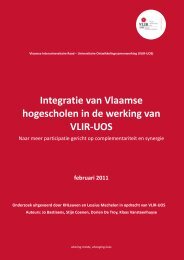Education Sector Development Program - VLIR-UOS
Education Sector Development Program - VLIR-UOS
Education Sector Development Program - VLIR-UOS
Create successful ePaper yourself
Turn your PDF publications into a flip-book with our unique Google optimized e-Paper software.
<strong>Education</strong> <strong>Sector</strong> <strong>Development</strong> <strong>Program</strong> IV<br />
Given its central<br />
importance within<br />
the context of <strong>Sector</strong><br />
Wide Approach<br />
(SWAp) and government<br />
driven planning and<br />
implementation, existing<br />
monitoring, review and<br />
evaluation processes will<br />
be strengthened.<br />
AOPs will need to be closely linked to the annual<br />
preparation of budgets. As a consequence, the<br />
fiscal year has to be taken as the reference year<br />
for the operational plan and coherence has to<br />
be established between operational planning<br />
and budget preparation schedules. For the sake<br />
of improved coherence between planning and<br />
budgetary process, the introduction of a program<br />
based budget would be advisable.<br />
Monitoring, review and evaluation (MRE)<br />
system<br />
A comprehensive system of interrelated<br />
and mutually supportive mechanisms for<br />
monitoring, review and evaluation will be<br />
developed. Given its central importance<br />
within the context of <strong>Sector</strong> Wide Approach<br />
(SWAp) and government driven planning<br />
and implementation, existing monitoring,<br />
review and evaluation processes will be<br />
strengthened.<br />
In line with the results-based approach<br />
adopted under ESDP IV it is intended to<br />
move to an outcome based MRE system<br />
and to strengthen formative and summative<br />
evaluation in addition to monitoring and<br />
review processes. This will be done by<br />
reinforcing the participative nature of the<br />
organizational structure and processes for<br />
MRE, and by defining a selected number of key<br />
performance (outcome) indicators for MRE (see<br />
below).<br />
Organizational structure for MRE<br />
In terms of organizational structure for MRE, two<br />
levels need to be distinguished. At a first level,<br />
since each Ministry process in charge of a specific<br />
program will prepare Annual Operational Plans<br />
(AOPs), these will form the basis for day to day,<br />
routine monitoring by program implementing<br />
units. The Regional Bureau level management<br />
will also prepare similar plans.<br />
At a second level, a Strategic Monitoring<br />
Sub-Committee (SMSC) will be established<br />
under the Joint Steering Committee with the<br />
particular responsibility of monitoring the plan<br />
implementation in a more comprehensive way.<br />
That is to say, to ensure information exchange<br />
and coordination between the different program<br />
implementing processes, and to deliberate<br />
collectively about higher level decisions to be<br />
made for keeping the plan implementation<br />
process on track. The Sub-Committee will be<br />
composed of MoE Process Owners and chaired by<br />
the Process Owner for Resource Mobilization and<br />
Planning. The Process of Resource Mobilization<br />
and Planning will act as the Secretariat for<br />
the Committee which should meet as often<br />
as required and at least half-yearly in order to<br />
ensure a meaningful monitoring process.<br />
The SMSC will directly report to the Joint<br />
Steering Committee, and will advise the Minister<br />
on major policy decisions required at critical<br />
moments of the plan implementation (especially<br />
on the occasion of the annual review, and midterm<br />
and final evaluation). This arrangement will<br />
also be applicable to the REBs and the two City<br />
Administrations.<br />
The Monitoring, review and evaluation<br />
(MRE) procedure<br />
The MRE procedure will be an interrelated and<br />
sequential chain of continuous monitoring,<br />
annual reviews and mid-term and final<br />
evaluations (organized at the occasion of ARMs).<br />
The MRE procedure will apply to both federal and<br />
decentralized levels.<br />
Routine monitoring at national and<br />
decentralized levels<br />
The plan implementation will be monitored on<br />
a routine basis through structured meetings<br />
within the different MoE processes based on the<br />
targets and indicators contained in the Annual<br />
Operational Plans. Similar monitoring procedures<br />
will also be put in place at decentralized levels<br />
of management (region and woreda levels).<br />
Short standardized written performance reports<br />
will be produced by the implementing units at<br />
half-yearly intervals using the guidelines and<br />
tools provided to them by the Secretariat of the<br />
Strategic Monitoring Sub- Committee.<br />
Routine monitoring reports will focus on<br />
progress in the production of planned outputs<br />
and outcomes, implementation of activities,<br />
utilization of inputs and budget implementation,<br />
implementation of recommendations issued by<br />
of the Annual Review Meeting. The reports will be<br />
submitted to the SMSC as a basis for reviewing<br />
progress, examining problems and constraints<br />
and recommending corrective action to be taken.<br />
Half-yearly reports will also be prepared by the<br />
regional level and submitted to the SMSC.<br />
In addition annual reports will be prepared as<br />
inputs to the Annual Review Meetings as a means<br />
of reporting on progress and management of<br />
programs as compared to Annual Operational<br />
Plans and ESDP IV outcomes<br />
92


